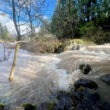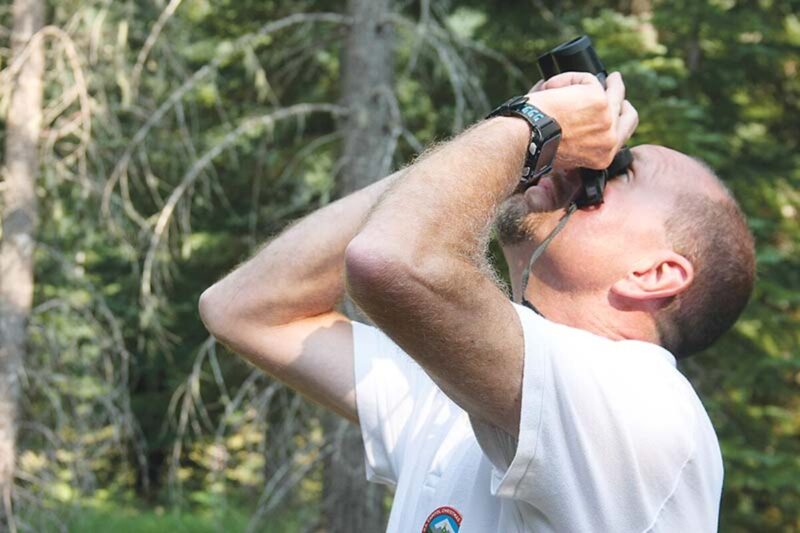Sean C. Morgan
The hunt for the U.S. Capitol Christmas Tree hit the final stretch last week with the arrival of the U.S. Government official who will make the final selection.
Willamette National Forest staff have narrowed down millions of trees to just five candidates to serve as the Capitol Christmas Tree.
Jim Kaufmann, director of the Capitol Grounds and Arboretum in the office of the Architect of the Capitol, spent three days last week inspecting the candidates. Wednesday, he took a look at a candidate growing at Big Springs Sno Park, with local media in tow.
In January, the U.S. Forest Service announced that the 2018 United States Capitol Christmas Tree would come from Oregon’s Willamette National Forest.
A gift from the Willamette National Forest and the State of Oregon to the people of the United States, the tree will be displayed on the West Lawn of the United States Capitol Building in Washington, D.C., with a public tree-lighting ceremony in early December 2018.
The Christmas tree will follow the Oregon Trail in reverse toward Washington, D.C.
Along with the local “tree team,” which includes foresters and a botanist, Kaufmann selected the national tree and a backup while visiting last week, but the tree and its location will not be announced until the week before it is cut, scheduled for Nov. 2. U.S. Forest Service staff intend to host a public program around the site of the tree when it is cut.
“We’re looking for a number of different things,” Kaufmann said. “It has to complement the building, so it has to be large.”
Ideally, the tree will be around 70 feet tall, Kaufmann said. It needs to be wide enough to fill the area but narrow enough to transport, about 30 feet.
“That gives us something to work with that’s manageable to work with and still maintain the scale,” Kaufmann said.
The tree also needs to be full all the way around it, he said. “It’s in the nation’s front yard!”
That’s more difficult to find, as trees shade each other and topography impacts the way trees grow.
“There’s millions of trees, but it’s almost like finding a needle in a haystack,” Kaufmann said.
The Big Springs candidate, a grand fir, was about 80 feet, Kaufmann noted as he walked around, inspecting it.
“It does have a nice tall, thin pyramid shape to it,” he said, which helps in transporting the tree.
The branches of the tree were thick and stiff, he said, and it has “pretty” bark.
“This has potential,” Kaufmann said.
This is Kaufmann’s first time picking the national Christmas tree, he said. “It’s the people’s tree. I can’t disappoint the American people and everybody who comes to the see this tree.”
He complimented the trees of the Willamette National Forest.
“They’re beautiful trees. It’s really nice to see the diversity in the forest.”
The forest has a wide range of species and color in a wide range of growing conditions, said Kaufmann, who is also horticulture manager for the U.S. Botanical Garden.
Molly Juillerat, a Middle Fork deputy district ranger who led the tree team, said that as soon as staff members knew the tree would come from the Willamette National Forest, they started the selection process. Staff members began putting trees on a list, and with a list of 15 to 20 possible trees, the team started making site visits to the identified candidates.
The tree team chose trees that are relatively easy to reach, while making sure no meadows or streams would be affected, Juillerat said. They narrowed the list to five trees, including two Douglas firs, one grand fir and two noble firs.
Four of the trees are on the Sweet Home Ranger District, Swanson said, but one is on the Middle Fork Ranger District.
The team also also is reaching out to other tree growers to collect 70 companion trees to be displayed in offices around Washington, D.C., Juillerat said. Most of those will be 6 to 8 feet tall, while a couple will be 10 to 15 feet tall for larger offices.
“We need one for Jim too,” Juillerat noted.
Kaufmann had admitted earlier that he uses an artificial Christmas tree at home.
Oregon must provide 10,000 ornaments for the trees.
Most of them are completed, said Sweet Home District Ranger Nikki Swanson, but 2,000 more large ornaments are needed within two months. They should be 9 to 12 inches and be sparkly and weather-proof.
Once cut, the tree will be stored at Murphy Veneer in the Foster area, Swanson said. The tree will exit Sweet Home in a lighted parade following a daylong celebration on Friday evening, Nov. 9, before an appearance in the Veterans Day Parade Nov. 10 in Albany.





